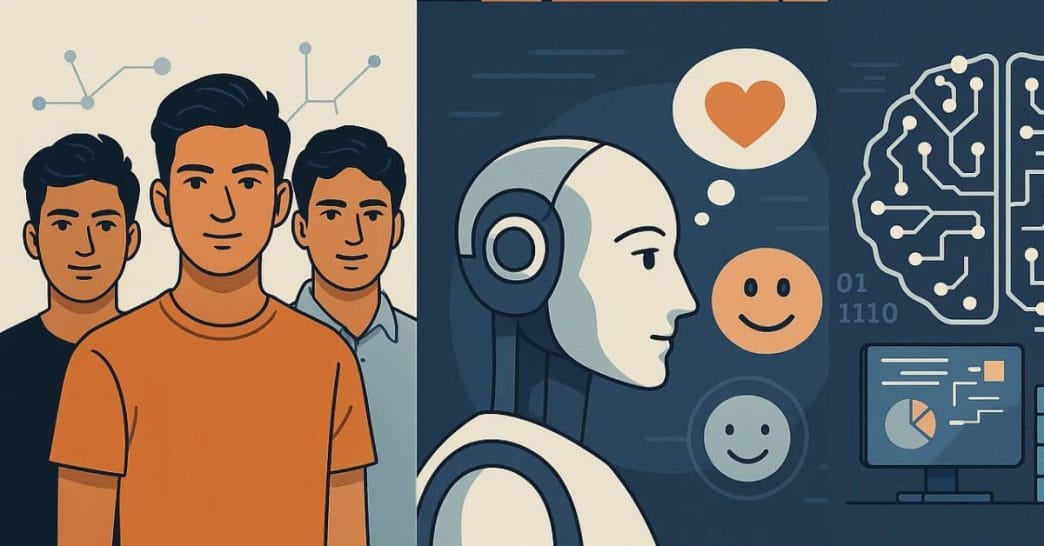At just 19 and early twenties, three Indian innovators are building an emotionally intelligent, token-efficient AI model that could change how the country competes in the global LLM race.
The Founders and Their Vision
HelpingAI is the brainchild of three Indian technopreneurs barely out of their teens: Abhay Koul (Chief AI Officer), Varun Gupta (CTO), and Nishith Jain (CEO).
- Abhay Koul: Over three years’ experience building and training custom AI models, including work with billion-dollar AI companies.
- Varun Gupta: Formerly at Appgud, brings startup scaling expertise and multi-sector product launches.
- Nishith Jain: AI model developer and community leader, previously built large-scale web apps and moderated one of India’s largest AI forums.
Their mission is straightforward but ambitious: “Revolutionize AI with emotional intelligence and transparent reasoning.” Dissatisfied with the limitations of legacy LLMs, they bootstrapped early R&D, pooled technical talent, and focused on three bottlenecks plaguing AI adoption in India — token inefficiency, empathy gaps, and latency.
Technical Architecture: How Dhanishtha Works
HelpingAI’s flagship model, Dhanishtha, incorporates several architectural departures from conventional transformer-based LLMs:
- Intermediate Reasoning: Unlike most models that complete reasoning before output, Dhanishtha parallelizes “thinking” and “speaking.” This mid-response reasoning significantly cuts both token use and latency.
- Scalable Model Sizes: Ranging from 2B to 15B parameters — small enough for mobile inference, large enough for enterprise-grade workloads.
- Hardware & Framework: Though backend details are undisclosed, indicators point to distributed GPU clusters, token-efficient transformer variants, and dynamic memory allocation for real-time cognitive updates.
- Training Data: Multilingual datasets from open web, code repositories, and domain-specific sources, plus emotionally tagged conversational data for sentiment handling.
- Optimization Techniques: Token compression (up to 5× fewer tokens than some competitors), early stopping, hyperparameter tuning, gradient clipping, and augmented datasets for under-represented contexts.
- Infrastructure: In-memory caching, auto-scaling cluster management, and high-speed data pipelines for low-latency delivery.
Innovations That Matter
HelpingAI’s two headline differentiators:
- Speed: Benchmarks suggest Dhanishtha is 4× faster than DeepSeek in inference thanks to its mid-response processing, a critical edge in low-infrastructure environments.
- Emotional Intelligence: A claimed 98.13 EI score — achieved via <think> blocks for reasoning traceability and <ser> blocks for sentiment-adaptive responses. This enables context-sensitive empathy, especially for healthcare and counseling applications where GPT often delivers generic emotional output.
Targeted Use Cases
HelpingAI’s deployment roadmap focuses on high-impact, high-context sectors:
- Enterprise Automation: HR, support, and customer service bots with empathy tuning.
- Healthcare & Telemedicine: AI triage, patient counseling, and mental health assistants.
- Education: Adaptive tutoring and assessment systems.
- Retail & eCommerce: Personalized marketing and inventory optimization.
- SMB & Developer Tools: Affordable API access for small businesses and startups.
- Other Verticals: Finance, logistics, and media content automation.
Core markets are India’s startups, healthcare providers, and service sectors — all underserved by Western LLMs in linguistic and cultural nuance.
Scaling Challenges in India — and HelpingAI’s Countermoves
Key barriers:
- Limited high-end compute infrastructure.
- Scarcity of specialist AI talent.
- Early-stage funding constraints beyond MVP stage.
HelpingAI’s solutions:
- Efficiency-first model design for low-spec deployment.
- Engagement with open-source AI communities for talent pipelines.
- Domain-specific enterprise partnerships for direct monetization.
- “Last-mile” integration tools for non-technical adopters.
Competitive Benchmarking
- Feature HelpingAI (Dhanishtha) DeepSeek GPT-4 / 4o
- Latency 4× faster than DeepSeek Fast, but slower than Dhanishtha Fast, but costly in inference
- Token Efficiency 5× fewer tokens than DeepSeek Moderate efficiency via MoE Lower efficiency for uncached queries
- Emotional Intelligence 98.13 score (claimed) High, but less than Dhanishtha Strong but less context-adaptive for Indian cases
- Multimodality Not yet Some variants Fully multimodal
- Fine-tuning Access Open API Flexible Restricted
Observation:
HelpingAI leads in speed, token use, and contextual empathy, but lags in multimodal capabilities — a gap that’s likely on their roadmap.
The Road Ahead
- Scale & Multimodal: Expanding parameter count and adding vision/speech modules.
- Ecosystem Partnerships: Collaborations with enterprises, government, and academia.
- Talent Development: Upskilling AI professionals domestically.
- Emerging Market Expansion: Targeting regions with similar infrastructure constraints.
- Trust & Transparency: Embedding visible reasoning steps for enterprise auditability.
HelpingAI is more than just a youthful AI startup story. It’s a calculated engineering response to the real constraints of India’s AI ecosystem — high-latency networks, cost sensitivity, and the need for culturally aligned empathy in AI. If it can close the multimodality gap and sustain its performance claims at scale, Dhanishtha could be India’s first credible homegrown rival to the world’s top LLMs.















